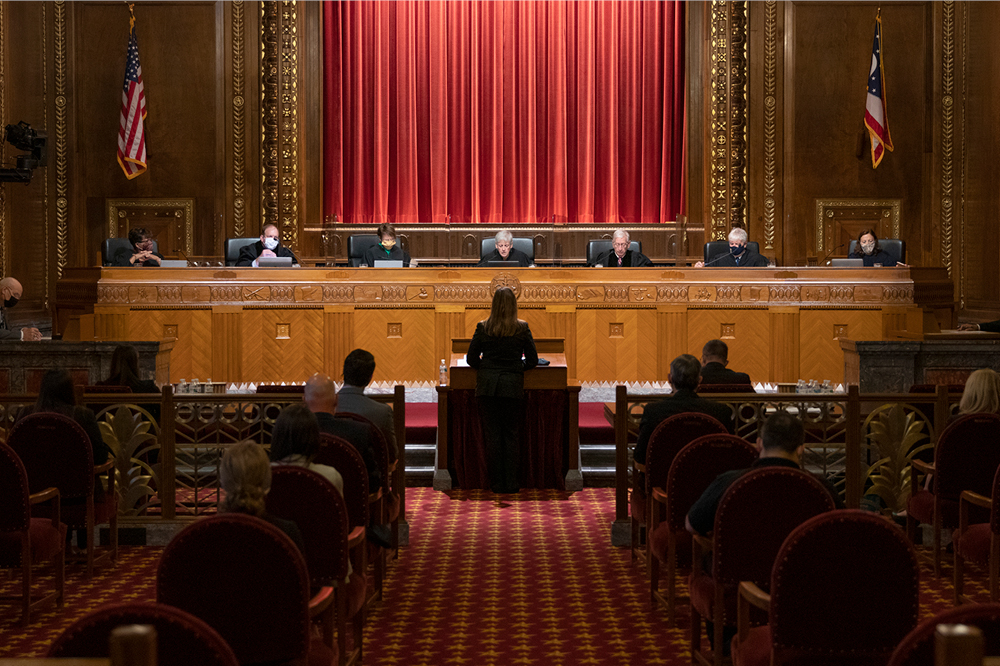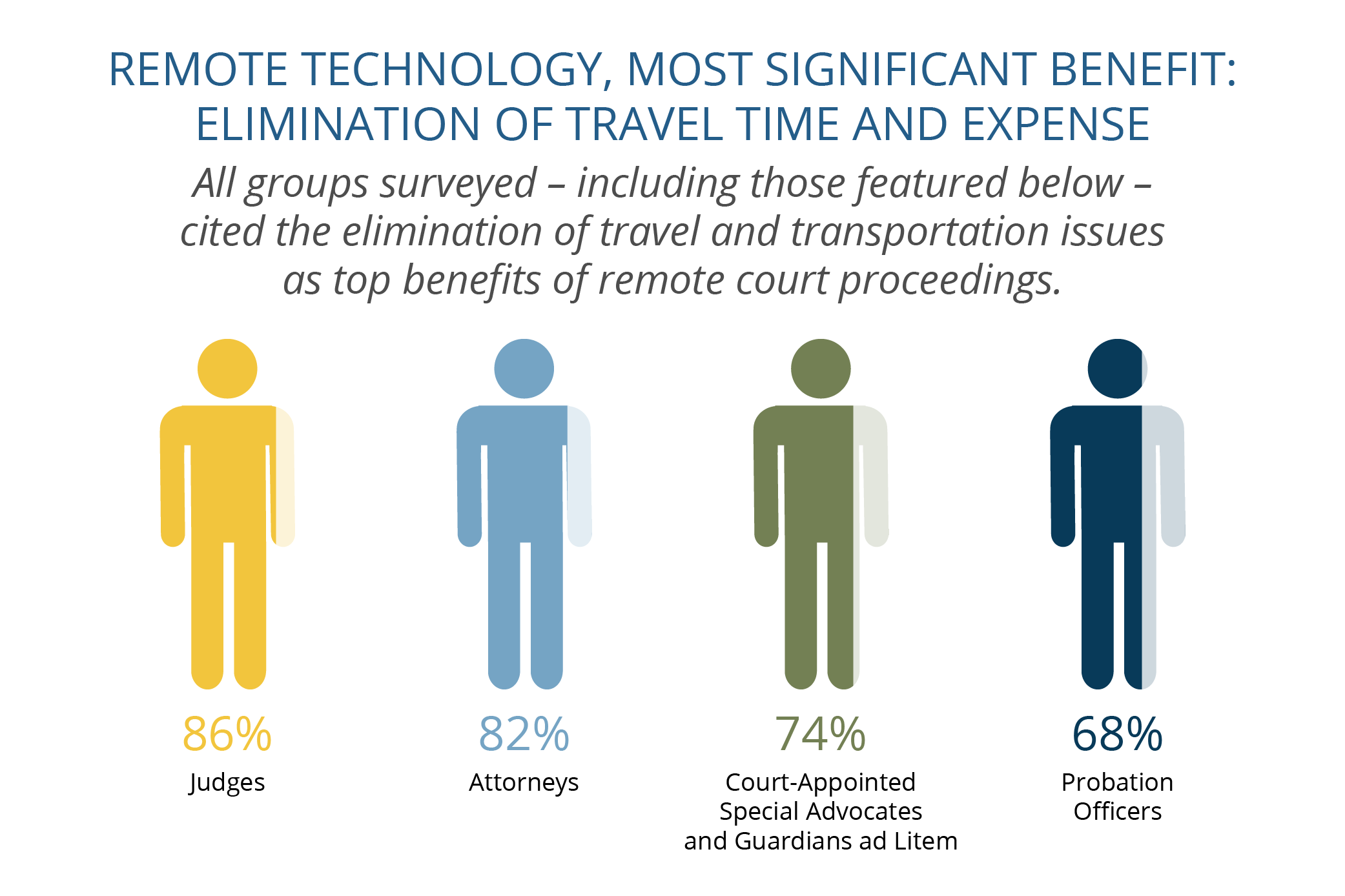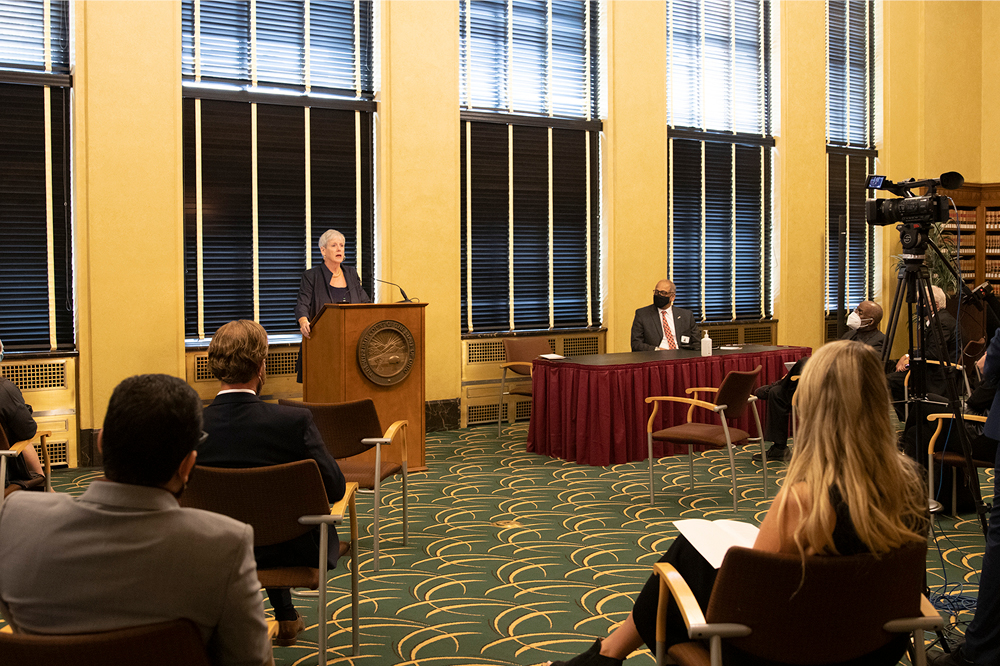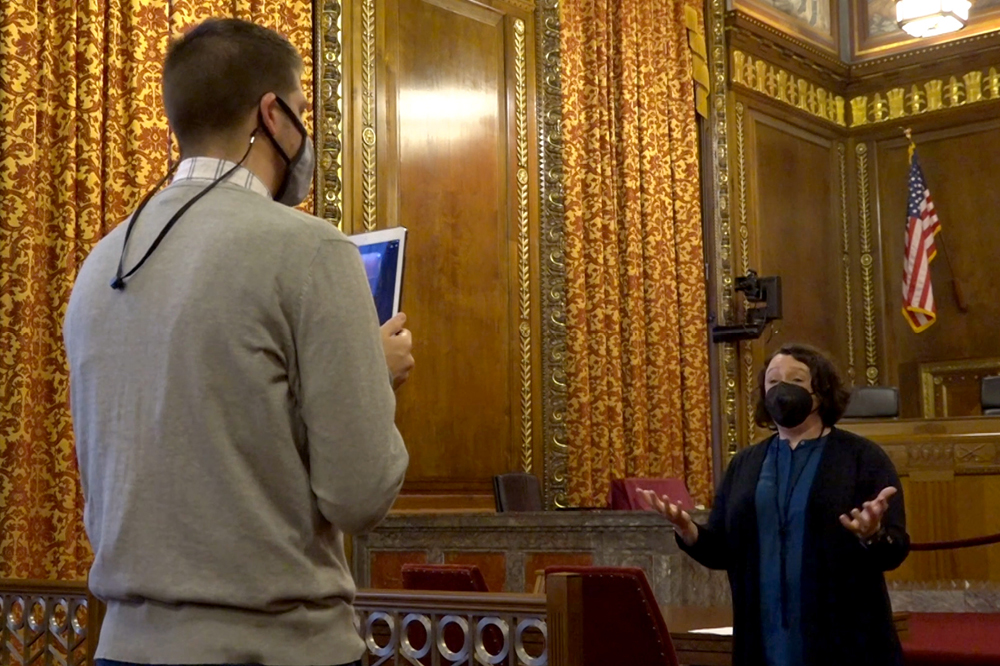Reflecting on 2021
In the past 12 months, the state’s courts continued to push forward in the new normal of video proceedings and other changes necessitated by COVID-19. The Ohio Supreme Court facilitated additional steps, including remote bar exams, grants to fund local technology upgrades, and virtual tours of the Thomas J. Moyer Ohio Judicial Center – all while hearing appeals, releasing the iCOURT task force report, and forging forward toward a statewide sentencing database.

As the pandemic persisted into 2021, the judicial branch kept adjusting to deliver its crucial services while considering health and safety precautions. Among the notable ongoing changes in the legal profession this year, law students and other applicants took the Ohio bar examination remotely in February and July. Those tests, which are administered by the Ohio Supreme Court, marked the second and third times they have been conducted remotely – the first occurring in October 2020.
The Supreme Court also continued to waive administrative rules that limit the number of continuing legal education (CLE) hours allowed by self-study. Webinars and online courses ballooned in the last two years to accommodate education requirements while avoiding in-person gatherings. The temporary change gives lawyers and judges more flexibility to fulfill their biannual CLE requirements.
For the May primaries and November general election, the Court encouraged lawyers to play a vital role in facilitating democracy by serving as poll workers. The program, which offered four hours of CLE credit, was instituted to replenish the shortfall of precinct officials caused by the pandemic.
The legal profession’s generosity was reflected in survey findings released this year showing an uptick in legal services given without charge to those in need. The Ohio Access to Justice Foundation reported that the average number of 2020 pro bono hours reported per attorney increased by 24% compared with 2019. Survey respondents logged 98,783 pro bono hours – a dollar value of more than $24.6 million in free legal services. Just over 10,000 hours were in direct response to issues arising from COVID-19.

After more than a year of online oral arguments, Ohio Supreme Court justices returned to the building in the fall to hear cases – joined by a new colleague, elected in November 2020.
Oral Arguments Return in Person by Fall
In spring 2020, the Court waded into its first oral arguments held by videoconference. The successful endeavor continued through the Court’s June 15 and 16 sessions of this year. In September, the justices returned to the Thomas J. Moyer Ohio Judicial Center, with a few precautions. Clear plastic dividers were set up between each justice’s space on the bench. Attorneys were required to wear masks in the Courtroom except while speaking at the lectern before the Court. Surfaces were disinfected. As in 2020, no scheduled oral argument sessions before the justices were postponed this year.
New Justice Takes Seat on Court
Justice Jennifer Brunner, elected to the Court in November 2020, had a most unusual start to a term. For her first oral argument as the 162nd justice, she logged on to Zoom and appeared in one of the seven squares showing justices on screen to ask questions of the attorneys. Before being elected, Justice Brunner served as a judge for six years on the Tenth District Court of Appeals and for five years on the Franklin County Common Pleas Court. She made history in 2007 when she became the first woman to serve as Ohio secretary of state and one of only five women elected to statewide office in a non-judiciary role. (Justice Brunner’s Pioneering Path Continues on Supreme Court)
Tech Grants Fund Court Upgrades and Innovations
When the pandemic hit, the state’s more than 300 courts were spurred to action, reshaping the way they did their work, primarily by turning to technology and driven by the imperative of not shutting down an essential branch of government. Numerous applications from local courts seeking Supreme Court technology grants in 2021 evidenced these new realities and a desire to incorporate what was working into the post-pandemic world.
The Court responded, issuing millions of dollars in funding. Prioritizing requests aimed at the continued use of remote technology and digital tools, Chief Justice Maureen O’Connor made a total of $8.65 million in awards for 143 local court initiatives.
“If COVID-19 has taught us anything, it’s that remote technology is crucial to ensuring our courts are open for those who need to be there, and for the public and the press to be afforded virtual access to court sessions,” Chief Justice O’Connor said.

A Court task force survey found that litigants overwhelmingly preferred remote proceedings and that court officials and attorneys saw numerous advantages.
Task Force Looks Ahead, Identifies Needs for Justice System
The unexpected catalyst of COVID became a “gateway to modernization” for courts, according to a special task force that studied how state courts relied on technology to stay open. The Improving Court Operations Using Remote Technology (iCOURT) Task Force delved into recent judicial branch successes and struggles with a view toward the future.
The result of the 25-member task force’s examination is a wealth of data and 97 detailed recommendations. The Ohio iCOURT report, released in the summer, catalogued survey feedback from not only thousands of judges, court officials, and attorneys but also litigants and justice partners, such as guardians, interpreters, and probation officers. Technical hurdles as well as practical and legal concerns were weighed to reimagine how courts can better administer and ensure justice going forward.
A few of the report’s conclusions: Courts must fully join the 21st century digital world. And, the lessons learned during the pandemic’s disruption are a blueprint for the judiciary in the years ahead.
The report points out that the guidance for Ohio courts doesn’t resolve every issue or concern. The hope, though, is that the report offers a foundation and inspiration for courts to keep updating their operations “and provide justice for all.”
Off-Site Court Program Restarts
After a two-year COVID interruption, the Court took its oral arguments directly to the people again in October. Close to 900 attendees, including 757 students from 12 local high schools, joined the justices in person in Summit County for arguments in six cases.
The Court typically travels twice each year to schools across the state, giving students a front-row perspective on the state’s court of last resort. This year’s visit marked only the second time the Court held two consecutive days of arguments outside of its home in Columbus. To date, 42,266 Ohioans – including 33,362 students – have witnessed the sessions firsthand as part of Off-Site Court.
Chief Justice and Elected Officials Open Doors for Eviction Relief
Chief Justice O’Connor teamed with elected officials in September to explain what Ohio courts could do to address concerns about rental evictions emanating from the pandemic.
“Ohio’s courts are venues that connect those in need to the rental assistance dollars distributed by the federal government and as a place to resolve disputes between all parties,” Chief Justice O’Connor said.
Participating with the chief justice in the forum to raise public awareness about resources for renters and property owners were U.S. Sen. Sherrod Brown, a central figure in the federal legislation that led to rental and utility relief funds, and Lakewood Municipal Court Judge Patrick Carroll.
A new resource published by the Court in September was highlighted. The Judicial Guide to Eviction Diversion Toolkit offers guidelines and strategies for developing proactive programs to prevent court filings, explains mediation and other forms of dispute resolution, and suggests community partnerships to obtain funds from the U.S. Department of Treasury’s Emergency Rental Assistance Program to help those financially impacted by COVID-19.

“Collecting data is essential if a business is to thrive, to grow, and to prosper. Why should the criminal justice system … or any facet of government be any different?” said Chief Justice O’Connor at the signing of a partnership agreement for a criminal sentencing database.
Strides Made Toward Sentencing Database
In October, representatives from the Court, the Ohio Criminal Sentencing Commission, and the University of Cincinnati (UC) signed a partnership agreement for criminal justice reform. The idea is to standardize felony sentencing in the state by constructing an online criminal sentencing database.
Trial courts in Ohio operate autonomously and don’t have information linked across jurisdictions due to different operating systems and varying approaches to the data that is entered. In a first step toward the development of the statewide database, the Criminal Sentencing Commission unveiled the Ohio Sentencing Data Platform in June to help courts implement a uniform sentencing entry system. The platform serves as a starting point to eventually track the entire spectrum of a criminal offense, from an arrest through the post-sentencing phases. That way stakeholders in the courts, law enforcement, corrections staff, and the legislature can more accurately assess what’s working, and more important, pinpoint elements that need reform.
The new collaboration with the university connects judges, academics, and other partners to UC’s information technology programmers to build a digital interface that can connect courts. In essence, the platform combines information from individual courts that have been separated in silos for decades.
Court Partnership First to Monitor Drug Court Participants
The Court is helping to bridge the information gap between the criminal justice system and healthcare providers in a landmark achievement this year for treating people struggling with substance use disorders.
In a collaboration with the Ohio Board of Pharmacy, the Court began reporting information from active adult drug court participants to the state’s prescription drug monitoring program known as OARRS – the Ohio Automated Rx Reporting System. It’s the first such program in the United States to offer a direct notification method between the judicial and healthcare realms to prevent pharmaceutical misuse.

When field trips to the Moyer Judicial Center had to be cancelled, the Court delivered the experience to students and teachers at home via virtual tours. Here, Civic Education Manager Sara Stiffler speaks to students about the ornate Courtroom while Civic Education Coordinator Mason Farr steadies the iPad for viewers.
Virtual Building Tours Render Many Upsides
During a typical year, approximately 13,000 people – mostly students and teachers – tour the Moyer Judicial Center. When the pandemic thwarted field trips to the Supreme Court’s home, the Civic Education Section found another way to share the building’s history and treasures, launching virtual tours for schools across Ohio.
As of early December, staff had led 49 virtual tours for approximately 1,545 students and 98 adults. It’s a novel approach to allow students and teachers to see the venue and learn about Ohio’s court system from the safety and comfort of their homes. Instead of the weeks or months sometimes needed to organize an in-person tour, virtual tour scheduling is more flexible, dates can be set in minutes, and the commute takes only seconds from a computer or mobile device.
Civic Education Undertakings Win National Attention
Virtual building tours are the kind of creative thinking that earned the Court’s Civic Education Program a national award this year. The program was honored in May with the 2021 Sandra Day O’Connor Award for the Advancement of Civics Education from the National Center for State Courts.
The annual award honors an organization, court, program, or individual who has promoted, inspired, improved, or led an innovation or accomplishment in the field of civics education related to the justice system. Ohio’s exceptional program was selected for its multi-faceted approach to civics education, continued program expansion, longevity, and its ability to be replicated in other jurisdictions around the country.
‘Prejudice and Progress’ Black History Documentary Series Premieres
This year the Court released the first two videos in a documentary series exploring racial injustice and the legal journeys of African Americans in the state. The series is called “Prejudice and Progress: A History of Racial Justice in Ohio.”
The inaugural video – released in February and titled “Knock the Monster in the Head: Benjamin Arnett versus The Ohio Black Laws” – covers the work of pioneering state Rep. Benjamin Arnett. He battled the “Black Laws,” a Northern version of the South’s Jim Crow statutes that denied free Black Americans their full rights in society.
The second in the series, “Crying for Answers,” highlights the reflections of retired Cleveland Municipal Court Judge Ronald Adrine on the 1968 assassination of Rev. Martin Luther King Jr. As a young lawyer in the 1970s, Judge Adrine was chosen as an investigator for the U.S. House Select Committee on Assassinations, which looked into the killings of King and President John F. Kennedy.
Justice Who Served in ’80s Discusses His Court Experience in Video Series
Former Justice James Celebrezze, a member of the Court from 1983 to 1985, was interviewed by Justice Patrick F. Fischer not long before Justice Celebrezze’s death in February. The Court’s 138th justice was the featured guest for the latest episode of “Reflections from the Bench,” the Court’s ongoing series of in-depth interviews with past justices. In the episode, released in October, Justice Fischer said theirs was “a lively discussion” and thanked former Justice Celebrezze’s family, who assisted with the production work for the episode and shared many family photos that became part of the video interview.
CREDITS:
Design: Ely Margolis
Web: Erika Lemke
Video Stories/Editing: Csaba Sukosd
